Holy Week processions in Guatemala




Holy Week in Guatemala is celebrated with street expressions of faith, called processions, usually organized by a "hermandades". Each procession of Holy Week has processional floats and steps, which are often religious images of the Passion of Christ, or Marian images, although there are exceptions, like the allegorical steps of saints.
History
The Catholic fervor that currently exists in Guatemala has almost magical and mystical dyes due to the syncretism between the Mayan religion and the Catholic doctrine; it combines elements dating from the old American cultures and from Catholicism imposed by the Spanish in the Colonial era.
Syncretism appears in subtle factors such as figure drawing of a butterfly on the sawdust carpet for a Christ procession, for the butterfly, for the Maya, more than a mere insect, symbolized the Sun -one of their most important deities- and also represented life and the afterlife. That image does not appear anywhere in Holy Week activities held in Spain.
Pre-columbine era
To understand the current Guatemalan Holy Week one must go back to the religion of the Maya, where there were amazing coincidences that perhaps helped the Catholic religion fit more with the beliefs of Native Americans. One of these similarities is that indigenous Guatemalans used a palanquin to transport wealthy citizens and rulers.[1][lower-alpha 1]
The cross is not exclusive of Judeo-Christian; even in Chiapas and parts of Huehuetenango it is still used to keep out evil spirits in some villages. Also as symbolic of purification, the Mayas fasted in the final five days of your calendar as well as for special holidays.
Juan Antonio Valdés, PhD in Archaeology[1]
For the natives it was not difficult to understand or accept the existence of the Holy Trinity because for them, the creators of this world were three, known by Mayan scholars as "G1", "G2" and "G3"; neither was to assimilate Virgin Mary, because they associated her with Ixchel -the moon, creative life- mother.[1]
Holy Week in Medieval Europe
Holy Week was created in the Council of Nicea -set up by the Roman Emperor Constantine I in the year 325 A.D.- because in that council it was decided when to celebrate Passover and how to calculate the date for the celebration. Subsequently, the Order of the Knights Templar promoted the praise for the Passion of Christ. After the disappearance of that order, -close order fourteenth century - the Franciscans were dedicated to preserve the traditions that had been acquired over time; they were the ones who developed the Via Crucis, one of the most representative aspects of the Holy Week festivities.[1]
The first liturgies were celebrated only among religious enclosed in churches, and sinners were not admitted. Later they evolved into processions where people took to the streets to express their guilt.[1]
Bourbon Reforms
In 1765 the Bourbon reforms were published by the Spanish Crown, which sought to recover the real power over the colonies and increase tax collection.[2] With these reforms, specific trade regulators were created to control the production of alcoholic beverages, snuff, gunpowder, playing cards and cock fights. The Royal Treasury auctioned annually some trade regulators and then bought them, thus becoming the owner of the monopoly of a certain product. That same year, four sub-delegations of the Royal Treasury were created in San Salvador, Ciudad Real, Comayagua and León and the political and administrative structure of the Captaincy General of Guatemala changed to 15 provinces.[3]
In addition to this administrative redistribution, the Spanish crown established a policy to diminish the power of the Catholic Church,[3] power that until then was virtually all over the Spanish vassals. The policy of reducing power of the church was based on the Enlightenment and had six main points:
- Decline of Jesuit cultural heritage
- Trend towards a secular and secularized culture
- Decidedly rationalist attitude
- Precedence of natural science over religious dogma
- Severe criticism of the role of the Church in society, especially the fraier and nun monasteries. These laws sought to limit excessive economic power of some brotherhoods, their large number, the lack of administrative and fiscal control by the authorities and public manifestations of piety, the latter listed as signs of backwardness and fanaticism, especially those of Holy Week.[4]
19th Century
After the overthrow and expulsion of members of Aycinena Clan in 1829, the Liberals ousted the regular orders and just left the secular clergy in the country, although without the fixed income from mandatory tithing.[5] This greatly weakened the Catholic Church in Guatemala, but after the failure of liberal governor Mariano Gálvez to combat an epidema of cholera morbus, parish priests incited the peasant population against him, and under the leadership of Rafael Carrera, drove Gálvez and liberal out of power. After a decade of government, Carrera allowed the return of the regular orders and conservative elite Catholics and authorized compulsory tithing again, reinforcing the Church in the country and the manifestations of faith such as Holy Week flourished. Indeed, in 1852, Guatemala and the Holy See signed a concordat in which the latter was entrusted with the education of the Guatemalan population and church-state union in the country was reinforced.[6]
After the fall of the Conservative regime and the Liberal victory in 1871, the Catholic Church suffered renewed attacks on its economic and political influence, as happened in 1829 when it was attacked by the Liberal government of Francisco Morazán. In 1873, the regular orders were again evicted, their property confiscated -including convents, haciendas and doctrines of Indians throughout the country- and mandatory tithing was abolished, leaving the secular clergy relegated to their parishes without stable income.[7]
Article 32: It guarantees the right of association for the various purposes of life, according to law. The establishment of monastic congregations and all kind of monastic institutions or associations, as well as the formation and operation of political organizations, either of international or foreign character is prohibited. Are not included in this prohibition, organizations that advocate the Central American Union and the Pan-American or continental solidarity doctrines.
Constitution of Guatemala of 1945[8]
In May 1891, Pope Leo XIII issued his Rerum Novarum encyclical -The situation of workers- key document that helped Catholic Church parishes gradually transform to fit in liberal states; in Guatemala this reorganization was reinforced by a new form of reproduction of ideas expressed in the press whose images and speeches were sent to the faithful for an efficient postal service developed by the Liberal State. The progress of Catholicism in the United States began to serve as an example in the reconquest of ideological power in totally liberal states.[9]
There was a strengthening of Catholicism during the government of General José María Reyna Barrios (1892–1898), thanks to the political opening of his government to secular clergy and his concern for the dissemination of art and the defense of local culture, which led him to subscribe to the Berne Convention, respecting the popular manifestations of faith, expressed primarily in the processions of the Passion of christ.[10] And this was accomplished even though Reyna Barrios was a high degree Freemason. However, the official entry of the regular orders was not allowed because the Guatemalan constitution forbid their presence in its soil at the time.[8]
20th Century
After the fall of Jacobo Arbenz regime, the Catholic Church regained some of the power he had had during the Conservative government of Rafael Carrera in the nineteenth century,[11] and as part of it, private religious education boomed from 1955 on, with the founding of several elite schools for boys which absorbed the elite students who had previously attended classes in secular government institutions.
Even though the Archbishop of Guatemala, Mariano Rossell y Arellano, published a letter explaining that the Catholic Church was not seeking privileges in its fight against Arbenz,[12] he managed to get that the government of Colonel Carlos Castillo Armas incorporated in the Constitution of 1956 these:
- the legal capacity of the Catholic Church-and all other churches- to acquire, hold and dispose of property, provided they are intended for religious and social work or education.[13]
- religious education was declared optional in official premises: Article 97 of the Constitution states that the law would regulate regard to religious education in official premises and that the State did not impart but declared optional. It also guarantees freedom of education in all other establishments.[14]
- the state would contribute to the maintenance of religious education: Article 111 states that private institutions providing free education will be exempt from certain state and municipal tax in compensation for their services.[15]
Rossell y Arellano started an aggressive campaign to get Catholicism back in Guatemala: he restored the Archbishop's Palace and the residence of Bishop Francisco Marroquín in San Juan del Obispo, Sacatepequez;[16] on July 22, 1953 he received fathers Antonio Rodríguez Pedrazuela and José María Báscones who began the work of Opus Dei in Guatemala;[17] and in 1959 held the First Central American Eucharistic Congress. Gradually he managed the get regular orders back to Guatemala and participated in several sessions of the Second Vatican Council, organized by Pope John XXIII.[18]
Over the years, and with advances in transportation and communication, the number of pilgrims and devotion to the Lord of Esquipulas made the city "Latin American Capital of Faith". In 1956 Pope Pius XII erected the Prelature Nullius Cristi of Esquipulas, which is formed by the Municipality of Esquipulas and its cathedral Sanctuary. The Pope also appointed as Prime Esquipulas Prelate Archbishop Rossell y Arellano. One of the first concerns of Rossell was seeking a religious community to take over the pastoral care of the temple; after many failed initiatives, he managed to find support from the Benedictine Abbey of San José in Louisiana, United States. On Palm Sunday of 1959, the first three Benedictine monks arrived at Esquipulas and founded the Benedictine Monastery.[lower-alpha 2] Considering many religious, cultural and historical aspects Blessed Pope John XXIII agreed to the request made by Bishop Rossell Arellano and raised the Sanctuary of Esquipulas to the rank of Minor Basilica in 1961.[18]
Holy Week art
Sculptures
Procession sculptures  María Magdalena y San Juan de la iglesia de La Merced, Antigua Guatemala 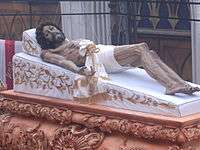 Cristo Yacente from La Recoleccion in Guatemala City. 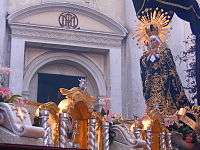 Virgen Dolorosa from La Recoleccion.  Procession sculptures from various churches. Guatemala City. |
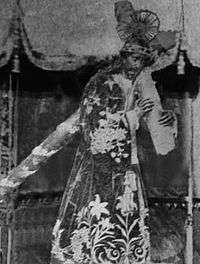 Jesús de Candelaria in 1898; Guatemala City  Mary of Magdala from La Merced, Antigua Guatemala 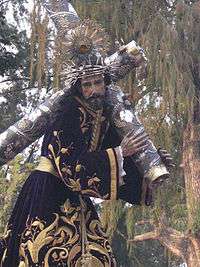 Jesús de la Merced, Guatemala City |
Arte efímero
Antigua Guatemala sawdust carpets  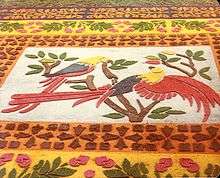 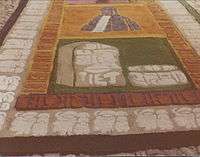  |
  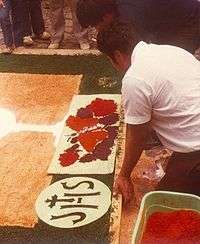  |
Processions
Guatemala City
| Day | Church | Original religious order since 1829 |
Current religious order since 1956 |
Sculpture | Hours | Film |
|---|---|---|---|---|---|---|
| Saturday before Palm Sunday | Iglesia de La Recolección | Propaganda Fide congregation | Franciscans | Jesús Nazareno del Consuelo | 10:00 am – 2:00 am | 1989 procession |
| Palm Sunday | Iglesia de Capuchinas | Jesús de las Palmas | 5:00 am – 12:00 pm | |||
| Palm Sunday | Iglesia de San José | Jesús Nazareno de los Milagros | 9:00 am – 1:00 am | 2014 procession | ||
| Holy Monday | Iglesia de La Parroquia | San Felipe Neri Congregation | Jesús Nazareno de las Tres Potencias[lower-alpha 3] | 3:00 pm – 12:00 am | 2011 procession | |
| Holy Tuesday | Iglesia de La Merced | Mercedarians | Jesuits | Jesús Nazareno del Perdón | 10:00 am – 12:00 pm | |
| Holy Tuesday | Iglesia de Beatas de Belén | Jesús Nazareno de la Indulgencia | 2:00 pm – 12:00 am | |||
| Holy Wednesday | Iglesia de Santa Teresa | Jesús Nazareno del Rescate | 3:00 pm – 12:00 am | 1969 procession | ||
| Holy Thursday | Iglesia de La Candelaria | Jesús Nazareno «Cristo Rey» | 7:00 am – 2:00 am | 2014 procession | ||
| Good Friday | Iglesia de La Merced | Mercedarians | Jesuits | Jesús Nazareno del Perdón | 7:00 am – 3:00 pm | 1991 procession |
| Good Friday | Iglesia de La Recolección | Congregación de Propaganda Fide |
Franciscans |
Señor Sepultado de La Recolección | 4:00 pm – 2:00 am | 2014 procession |
| Good Friday | Iglesia de El Calvario | Señor Sepultado de El Calvario4:00 pm – 3:00 am | 2011 crucifixion | |||
| Good Friday | Iglesia de Santo Domingo | Order of Preachers | Order of Preachers[lower-alpha 4] | Cristo del Amor | 4:00 pm – 2:00 am | 2014 procession |
Antigua Guatemala
| Day | Sculpture | Church | Hours |
|---|---|---|---|
| Fifth Sunday of Lent | Jesús de la Caída | San Bartolomé Becerra | 7:00 am – 10:00 pm |
| Friday before Holy Week | Hermano Pedro Viacrucis (male only) | San Francisco el Grande | 3:00 pm – 6:00 pm |
| Palm Sunday | Palm procession | Iglesia de Jocotenango Sacatepéquez | 6:30 am – 12:00 pm |
| Palm Sunday | Palm procession (live) | Iglesia de La Merced, Iglesia de Santa Ana, Iglesia Escuela de Cristo, Iglesia de San Felipe de Jesús | 8:00 am – 12:00 pm |
| Palm Sunday | Jesús Nazareno de la Reseña | La Merced | 11:00 am – 11:00 pm |
| Holy Monday | Jesús Nazareno | Santa Inés del Monte Pulciano | N/A |
| Holy Tuesday | Jesús Nazareno del Silencio | El Calvario | 4:00 pm – 11:00 pm |
| Holy Wednesday | Jesús Nazareno del Milagro | San Felipe de Jesús | 2:50 pm – 10:00 pm |
| Holy Wednesday | Jesús Nazareno | San Mateo Milpas Altas | 4:00 pm – 10:00 pm |
| Holy Thursday | Jesús Nazareno de la Humildad | San Cristóbal el Bajo | 11:00 am – 10:00 pm |
| Holy Thursday | Jesús Nazareno del Perdón | San Francisco el Grande | 1:00 pm 12:00 am |
| Good Friday | Jesús Nazareno de la Penitencia | La Merced | 4:00 am – 3:00 pm |
| Good Friday | Acto de Crucifixión | Parroquia de San José Catedral, Escuela de Cristo | 12:00 pm – 3:00 pm |
| Good Friday | Señor Sepultado y Virgen de Soledad | Parroquia de San José Catedral | 3:00 pm – 1:00 am |
| Good Friday | Señor Sepultado | San Felipe de Jesús | 3:00 pm – 1:00 am |
| Good Friday | Señor Sepultado | Escuela de Cristo | 4:00 pm – 1:00 am |
See also
General:
- Public holidays in Guatemala
- Chivarreto boxing- a sports tournament held annually on good friday near Guatemala City
Notes and references
Notes
- ↑ As shown in the Ratinlinxul Cup, From Alta Verapaz, where the is a painting of a procession with a nobleman sit on top of several servants that are carrying him. Behind them there are five musicians, with instruments similar to trumpets. Also, a door frame in Temple I in Tikal has an sculpted scene in which a divine lord (K’ul Ahaw) is being carried on the shoulders of several people.
- ↑ United Fruit Company headquarters were in New Orleans at the time.
- ↑ Also known as "Jesús Nazareno de los Nobles" in Antigua Guatemala and as "Jesús Nazareno of the poor" in Guatemala city after the earthquakes of 1917-18.
- ↑ The Order of Preachers returned to Guatemala in 1956.
References
- 1 2 3 4 5 Villalobos 2009.
- ↑ Melchor Toledo 2011, p. 110.
- 1 2 Melchor Toledo 2011, p. 111.
- ↑ Melchor Toledo 2011, p. 112.
- ↑ González Davison 2008, p. 4-15.
- ↑ Aycinena & 1854 2-16.
- ↑ Martínez Peláez 1990, p. 842.
- 1 2 Asamblea Nacional Constituyente 1945, p. 7.
- ↑ Semana Santa en Guatemala n.d., p. 1.
- ↑ Semana Santa en Línea n.d., p. 1.
- ↑ Sabino 2007.
- ↑ Rossell y Arellano 1954.
- ↑ Asamblea Constituyente 1956, p. Article 50.
- ↑ Asamblea Constituyente 1956, p. Article 97.
- ↑ Asamblea Constituyente 1956, p. Article 111.
- ↑ Asociación de Amigos del País 2004.
- ↑ Rodríguez Pedrazuela 1999.
- 1 2 Esquipulas online n.d.
Bibliography
- Asamblea Constituyente (1945). "Constitución política de la República de Guatemala" (PDF) (in Spanish). Guatemala: Asamblea Nacional Constituyente. Retrieved 4 December 2014.
- Asamblea Constituyente (1956). "Constitución de la República de Guatemala" (PDF) (in Spanish). Guatemala: Asamblea Nacional Constituyente.
- Asociación de Amigos del País (2004). Diccionario Histórico-Biográfico de Guatemala (in Spanish). Guatemala: Amigos del País.
- Aycinena, Pedro de (1854). Concordato entre la Santa Sede y el presidente de la República de Guatemala (in Latin and Spanish). Guatemala: Imprenta La Paz.
- Esquipulas online (n.d.). "Biografia de Mariano Rossell Arellano". Esquipulas en línea. Esquipulas, Guatemala. Retrieved 1 September 2014.
- González Davison, Fernando (2008). La montaña infinita; Carrera, caudillo de Guatemala (in Spanish). Guatemala: Artemis y Edinter. ISBN 84-89452-81-4.
- Martínez Peláez, Severo (1990). La patrio del criollo; ensayo de interpretación de la realidad colonial guatemalteca (in Spanish). México, D. F.: Ediciones en Marcha.
- Melchor Toledo, Johann Estuardo (2011). "El arte religioso de la Antigua Guatemala, 1773-1821; crónica de la emigración de sus imágenes" (PDF). tesis doctoral en Historia del Arte (in Spanish). México, D. F.: Universidad Nacional Autónoma de México. Archived from the original (PDF) on 17 December 2014. Retrieved 10 November 2014.
- Periodismo Católico (2011). "Los tres viajes de Juan Pablo II dejaron paz y esperanza". Prensa Libre (in Spanish). Guatemala. Archived from the original on 25 December 2014. Retrieved 17 March 2013.
- Rossell y Arellano, Mariano (1954). Declaración contra la demagogia comunista y liberal. La Iglesia no busca privilegios (in Spanish). Guatemala: Arzobispado de Guatemala.
- Semana Santa en Línea (n.d.). "Crónicas y recuerdos de Jesús Nazareno de Candelaria, 1891-1900". Semana Santa en Línea (in Spanish). Guatemala. Archived from the original on 2 March 2015. Retrieved 28 February 2015.
- Villalobos, Roberto (2009). "Sincretismo guatemalteco" (in Spanish). Retrieved 15 February 2013.
External links
![]() Media related to Holy Week in Guatemala at Wikimedia Commons
Media related to Holy Week in Guatemala at Wikimedia Commons